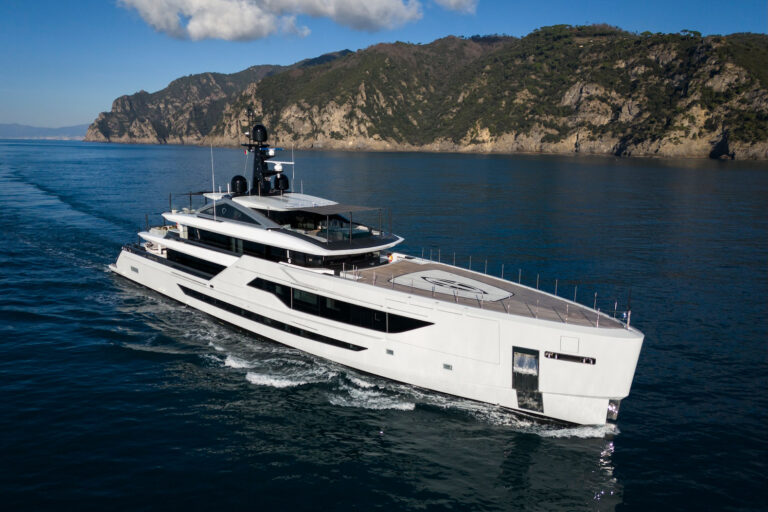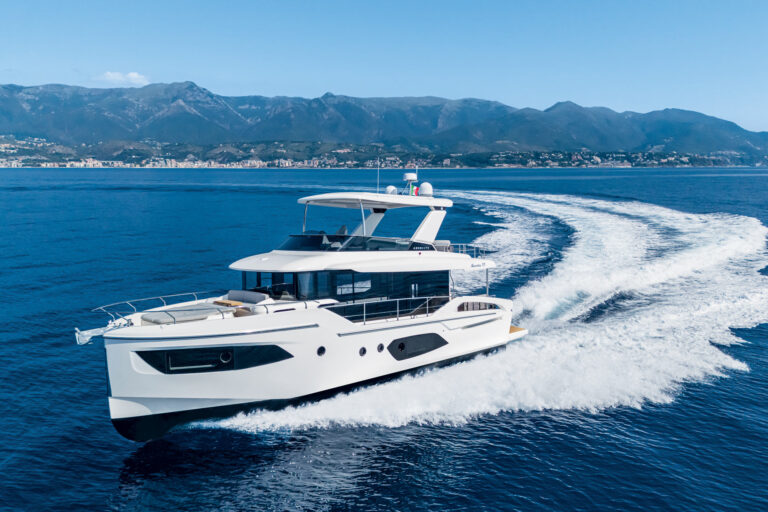EMS Satcom, a division of EMS Technologies, is a company highly regarded in the realm of terrestrial satellite communication. Recently, in cooperation with Rhode Island company SeaWave, it introduced an innovative satellite-communications solution for those of us who favor offshore locales. The system comprises two components-SeaWave’s Integrator 3.0 interface module and EMS Satcom’s Fleet 55 satellite terminal-which team up to create one multi-port communication system. With its wide area of coverage and least-cost routing for phone, fax, data, video and Internet services, the system is sure to be a welcome addition to any yacht heading afar.
I saw the system in action on board a Hatteras motoryacht at this past year’s Ft. Lauderdale International Boat Show. The system’s dome-shape Fleet 55 antenna had been installed the day before my visit, a task simplified by the antenna’s relatively small size and light weight (less than 40 pounds). The antenna can automatically track the satellite, with no constraints on successive and cumulative changes in the vessel’s heading. The system’s gyroscopic stabilization should be more than adequate, as it is designed to withstand roll of ±30 degrees for periods greater than 8 seconds, pitch of ±10 degrees for periods greater than 6 seconds and yaw of ±8 degrees for periods greater than 50 seconds. The system also allows for vessel turn rates up to ±6 degrees per second and speeds up to 30 knots. With this level of antenna performance, signal loss should be rare.
The belowdecks unit for the antenna is about as large as a letter-size piece of paper, stands 3 inches tall and weighs 51/2 pounds. Though it has a built-in control panel, you can mount it in an out-of-the-way location and control its functions from your PC. This way, your boat isn’t cluttered by yet another black box.
The SeaWave Integrator 3.0, designed to be mounted out of sight, measures 17 by 14.4 by 31/2 inches and weighs 25 pounds. In addition to hookups for the Fleet 55 equipment, the Integrator 3.0 has a number of built-ins, including a GSM cellular phone, an Iridium phone and a GPS receiver. The unit also has interface connections for the vessel’s telephone/fax system, MF/HF SSB radio and a computer-network cable.
In most cases, the only visible component will be a standard personal computer equipped with Windows-not only can it display a virtual control panel, which allows you to manage the entire system, it allows you to set up and access logs detailing use of the system. This same computer can serve as an input/output terminal. Installing a Wi-Fi card will enable two-way, wireless communication with any similarly equipped computer on board.
Inmarsat’s Fleet geostationary-satellite system provides global coverage. Data-transfer rates are dependent, in part, on your boat’s location and the type of onboard equipment you are using. Large ships, for example, generally carry Fleet 77 terminals, which have antennas about 30 inches in diameter. Use of these large antennas ensures communication over all waters, except those in polar areas. The smaller Fleet 55 system uses the same satellite network, but its antennas are smaller (just over 21 inches in diameter) and operate best when in the “footprint of an Inmarsat satellite’s spot-beam antenna. The spot-beam footprint is an area on the Earth’s surface served by a high-gain directional antenna on the satellite. Spot beams are positioned to serve areas with the greatest volume of communication traffic. When operating in Inmarsat’s Fleet 55 spot-beam coverage areas, communication choices include voice, video, 3.1 kHz audio, 64 kbps mobile ISDN, 14.4 kbps G-3 fax or full-capability G-4 fax, and mobile packet data service. In the event your requirements exceed the 64 kbps limit, you can link two EMS Satcom Fleet 55 systems, which will create a 128 kbps channel more suitable for large transfers of data.
The SeaWave Integrator 3.0 automatically controls access to the Inmarsat and Iridium satellite systems, the GSM cellular telephone and the vessel’s HF/SSB radio. (GSM cellular telephones are used in most of Europe, many other parts of the world and plenty of North American cities.) The Iridium satellite system provides voice and digital-data coverage over virtually all oceans. The inclusion of HF/SSB radio ensures access to a number of e-mail services, as well as public-correspondence coast stations.
The system automatically provides least-cost routing for voice communication and data transfers based on your yacht’s position, which is supplied by the Integrator 3.0’s GPS receiver. SeaWave’s proprietary data-compression software minimizes the impact on the communication channel, allowing you to send and receive virtually any type of file, including word-processing documents, images and spreadsheets. E-mail is transferred through the Integrator 3.0 with all addressing intact. Transmission speeds depend on the communication portal selected by the system. In addition to transferring data, fax messages and voice communication, the system will receive NOAA weather forecasts.
The Satcom Fleet 55 communications system automatically provides optimum performance at a minimum cost, without the need for a professional communications specialist. Those who enjoy the complicated process of managing communications may at first miss the romance of being the “Sparks on their yachts, but I suspect that romance will fade. After all, it’s tough to beat the convenience of contacting anyone, virtually anywhere, at any time. Base price: about $19,000.
Contact: EMS Satcom, (800) 600-9759; www.ems-t.com. SeaWave LLC, (800) 746-6251; www.seawave.com.









